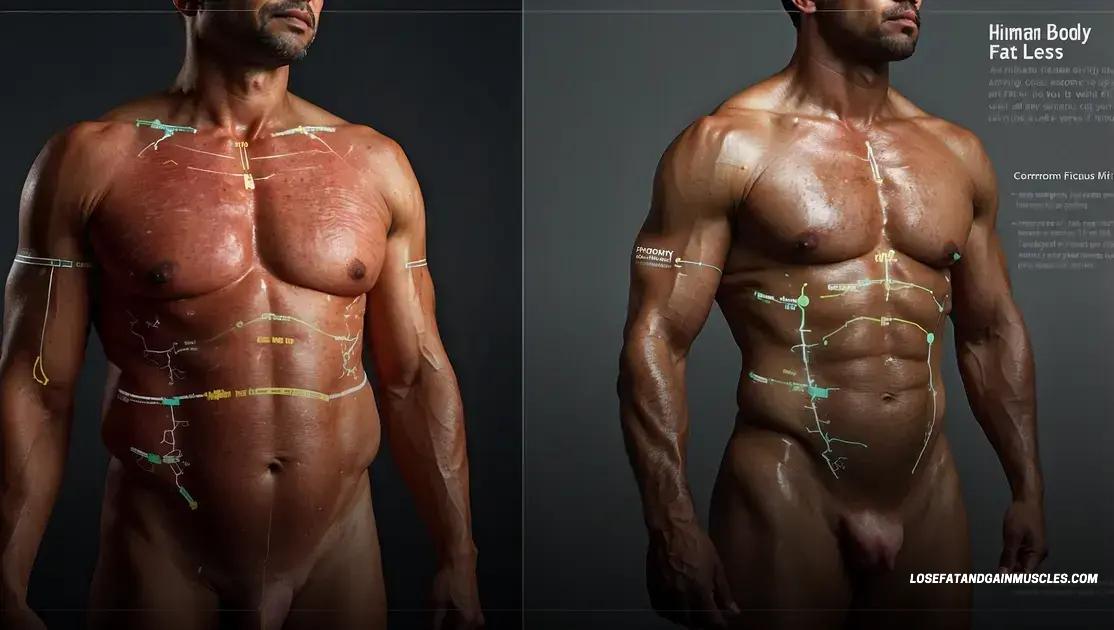Should I Lose Fat Before Building Muscle? Unlocking Fitness Secrets!
Deciding whether to lose fat before building muscle depends on your individual goals and current body composition. Losing fat first can improve health and metabolic function, while focusing on muscle gain is ideal after achieving a healthy weight. Personalizing your approach ensures optimal results.
Are you wondering, “Should I lose fat before building muscle?” This question comes up frequently among fitness enthusiasts who are trying to optimize their workouts and achieve their physique goals. In this article, we will dive deep into the advantages, drawbacks, and expert insights for effectively managing your body composition. Whether you’re a beginner or a seasoned athlete, understanding whether to prioritize fat loss or muscle gain can significantly influence your results and improve your overall health.
Understanding the Fat Loss vs Muscle Gain Debate
When it comes to fitness goals, the debate over fat loss vs muscle gain is a common one. Many individuals wonder whether they should focus on losing fat first before starting to build muscle. Understanding these two processes can help clarify this decision.
Defining Fat Loss and Muscle Gain
Fat loss occurs when the body uses stored fat as energy, leading to a decrease in overall body fat percentage. This often involves a combination of dietary changes and increased physical activity. Meanwhile, muscle gain happens when muscle fibers repair and grow stronger after being stressed through resistance training. This process requires adequate protein intake and sometimes a caloric surplus.
The Importance of Body Composition
Body composition refers to the ratio of fat to lean mass in the body. Improving body composition is a primary goal for many fitness enthusiasts. A lower fat percentage combined with increased muscle mass often leads to better overall health, improved metabolism, and enhanced physical performance.
Can You Do Both at Once?
Some people question whether it is possible to lose fat while simultaneously gaining muscle. While body recomposition is feasible, especially for beginners, it often requires precise calorie and macronutrient management. For more experienced lifters, focusing on one goal at a time tends to yield better results.
Factors to Consider
Several factors can influence whether an individual should prioritize fat loss or muscle gain. These include current body composition, fitness level, health status, and personal goals. For example, someone with a higher body fat percentage may benefit more from focusing on fat loss first, while someone with a lower fat percentage might see better results by concentrating on muscle gain.
Conclusion of the Debate
Ultimately, the choice of whether to focus on fat loss or muscle gain depends on individual goals and circumstances. Each path has its merits, and the best approach is one that aligns with personal fitness aspirations and promotes overall health.
Benefits of Losing Fat First

There are several benefits of losing fat first when embarking on a fitness journey. Understanding these advantages can help individuals make informed decisions about their training and nutrition strategies.
Improved Health Markers
Losing excess body fat can lead to better overall health. Lowering body fat reduces the risk of chronic diseases, such as heart disease, diabetes, and certain cancers. Improved blood pressure, cholesterol levels, and blood sugar control are also common benefits of fat loss.
Enhanced Metabolic Function
Reducing body fat enhances metabolic function. A lower body fat percentage often results in better insulin sensitivity, which helps the body manage glucose more effectively. This can make it easier to maintain energy levels and support muscle growth when you do shift focus to building muscle.
Better Exercise Performance
Reducing body fat can improve exercise performance. With less weight to carry, many individuals find it easier to perform cardio and resistance training exercises. This can enhance endurance and allow for greater mobility and agility during workouts.
Boosted Confidence and Motivation
Many people find that losing fat first boosts self-confidence and motivation. Seeing physical changes can serve as positive reinforcement, encouraging individuals to stay committed to their fitness journey. This increased confidence can also make exercising more enjoyable.
Foundation for Muscle Growth
Losing fat first can provide a solid foundation for future muscle growth. By establishing healthy eating habits and consistent workout routines, individuals can better prepare their bodies to add muscle effectively when they switch their focus. This can lead to more sustainable and long-term results.
Drawbacks of Losing Fat Before Muscle Building
While there are benefits to losing fat before building muscle, there are also some drawbacks to consider. Understanding these limitations can help you make better decisions regarding your fitness journey.
Potential Muscle Loss
One significant concern when focusing solely on fat loss is the potential for muscle loss. When in a caloric deficit, the body might break down muscle for energy, especially if protein intake is insufficient. This can hinder overall progress and lead to a less toned appearance.
Plateauing Progress
Focusing too much on fat loss can lead to plateaus in progress. As your body adapts to a lower caloric intake, weight loss can slow down or stop altogether. This makes it difficult to continue making progress toward your goals.
Decreased Energy Levels
Engaging in a strict fat loss routine can often leave individuals feeling fatigued. A caloric deficit, combined with intense workouts, may lead to lower energy levels. This can affect your workouts, making it harder to perform exercises at the intensity required for muscle growth.
Mental and Emotional Challenges
Prioritizing fat loss can sometimes create mental and emotional challenges. Strict dieting and the pressure to see quick results can lead to feelings of frustration and disappointment if progress stalls. This can negatively impact motivation and overall mental well-being.
Complicated Nutritional Needs
Navigating your nutritional needs can become complex when focusing primarily on fat loss. Individuals may find it challenging to balance macronutrients and ensure adequate protein intake for muscle maintenance while trying to lose fat. This complexity can lead to confusion and ineffective dieting strategies.
When to Focus on Muscle Building

Knowing when to focus on muscle building is essential for achieving your fitness goals. Certain conditions and stages in your fitness journey make it more beneficial to switch your goals from fat loss to muscle gain.
After Achieving a Healthy Body Fat Percentage
Once you have reached a healthy body fat level, it may be time to shift your focus to muscle building. A good marker to assess this is if your body fat percentage is within the range of 10-20% for men and 18-28% for women. At this point, building muscle can enhance your physique and improve strength.
When You Feel Physically and Mentally Prepared
Your mental and physical readiness plays a significant role. If you feel strong and motivated to engage in more intense training, this can be a great time to concentrate on building muscle. Mental readiness can improve adherence to workouts and nutrition plans.
After Establishing a Solid Workout Routine
If you have successfully established a consistent workout routine, transitioning to muscle building can be effective. Having a well-rounded program, including strength exercises and proper rest, is crucial before focusing solely on muscular gains.
When Nutritional Needs Are Met
Before you shift your focus, ensure that your nutritional intake is aligned with muscle-building goals. Consuming enough protein, carbohydrates, and essential healthy fats is critical. When your diet supports your performance, you are better set up for muscle building.
When Recovering from Previous Fat Loss
If you have just completed a fat loss phase, consider prioritizing muscle building. Your body may be primed to gain muscle after a period of caloric restriction. By gradually increasing calorie intake, you can promote muscle growth while minimizing fat gain.
Personalized Strategies for Optimal Results
Implementing personalized strategies for optimal results is key to successfully achieving your fitness goals. Everyone’s body and circumstances are different, making it essential to tailor your approach according to your individual needs.
Assess Your Current Fitness Level
Start by evaluating your current fitness level. Are you a beginner, intermediate, or advanced? Understanding where you stand can help you choose the right workout intensity and nutrition plan. This assessment will guide you in setting realistic and achievable goals.
Set Clear, Specific Goals
Establish clear and specific goals related to fat loss and muscle gain. Goals like “I want to lose 10 pounds in three months” or “I want to lift 20% more weight in six weeks” provide direction. Write them down and track your progress to stay motivated.
Create a Balanced Workout Plan
Your workout routine should include a mix of strength training, cardio, and flexibility exercises. For optimal results, aim for at least 150 minutes of moderate aerobic activity weekly, complemented by strength training two to three times a week. Personalize this plan based on your preferences and schedule.
Focus on Nutrition
Nutrition is a critical factor for both fat loss and muscle gain. Consult a professional to create a meal plan that meets your caloric and macronutrient needs. Ensure you include enough protein to support muscle recovery and growth, while also incorporating whole grains, fruits, and vegetables.
Monitor and Adjust as Needed
Regularly monitor your progress and be open to adjustments. If you’re not seeing results, consider modifying your workout intensity or dietary habits. Flexibility in your approach can help you overcome plateaus and continue making progress toward your fitness goals.
In Conclusion: Finding Your Optimal Path in Fitness
Deciding whether to focus on fat loss or muscle building is a common challenge for many fitness enthusiasts. Understanding the dynamics between these two goals enables you to tailor your fitness strategies for optimal results.
By evaluating your current fitness level, setting specific goals, and personalizing your workout and nutrition plans, you put yourself in a strong position to excel. Remember that it is important to monitor your progress and adjust your strategies as needed.
Ultimately, whether you choose to lose fat first or build muscle, being consistent and dedicated will lead to significant improvements in your overall health and fitness journey. Embrace the process, and you will unlock your fitness secrets!
FAQ – Frequently Asked Questions about Losing Fat Before Building Muscle
Should I lose fat before focusing on muscle gain?
It depends on your personal goals and current body composition. If you have a higher body fat percentage, losing fat first may be beneficial.
What are the benefits of losing fat first?
Losing fat first can improve overall health, enhance metabolic function, and boost confidence, which can make the transition to muscle building easier.
Are there drawbacks to losing fat before building muscle?
Yes, potential drawbacks include muscle loss, plateaus in progress, decreased energy levels, and increased mental challenges.
When is the best time to focus on muscle building?
Focus on muscle building when you achieve a healthy body fat percentage, feel physically prepared, and have established a solid workout routine.
What strategies can I use for optimal results?
Personalized strategies include assessing your current fitness level, setting specific goals, creating a balanced workout plan, and monitoring your progress regularly.
How can I assess my progress effectively?
Track your workouts, monitor changes in body composition, and adjust your nutrition based on your results to ensure you stay on track.













